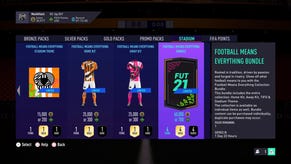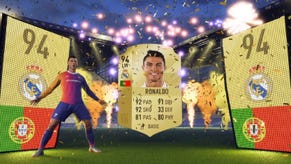FIFA 22 Chemistry explained: how to increase Team Chemistry, Individual Chemistry, and max Chemistry in Ultimate Team
How Chemistry works in FIFA 22, and how to get the most out of it.
Chemistry in FIFA 22 Ultimate Team is without doubt the most important thing to master.
Finding the right combination of Individual Chemistry, Team Chemistry, and Chemistry Styles - three factors that we'll explain below - can set you up for a whopping total of 90 points increase across each player's attributes, averaging at about 10 points increased to each skill affected by a Chemistry Style modifier. That's roughly the equivalent of turning a Silver card into a Gold, or a standard Gold into a top-tier, in-form rare card.
Basically, Chemistry makes a big difference to how good your players are - both positive and negative. After years of pouring over stats, attributes, and little green chevrons by the community, EA Sports has since revealed some numbers, so we explain how it all works below in our guide to how to increase Chemistry in FIFA 22 Ultimate Team.
On this page:
FIFA 22 Chemistry explained: how Team, Individual, and FUT Chemistry works
FUT Chemistry can seem a little complicated at first - especially when you start looking at the actual equations behind it. We're going to start right at the beginning for now, explaining what Chemistry is and the basics of how it works.
There are two types of Chemistry in FIFA Ultimate Team, which make up an overall Chemistry rating, plus the Chemistry Style modifiers which affect how they work. Here are the key terms:
- Individual Player Chemistry - Rated out of 10 for each player.
- Team Chemistry - Rated out of 100 for the entire team.
- Overall Chemistry - This is a hidden number, which comes from a combination of Individual Player Chemistry and Team Chemistry. A high Overall Chemistry will increase player attributes; a low Overall Chemistry will actually decrease them.
- Chemistry Styles - Modifiers which affect which stats are increased, and how much they're increased by, when you have a strong Overall Chemistry.
Ultimately, the reason you want a high Player and Team Chemistry is because they increase or decrease your players' attributes when they get into a match by a potentially huge amount.
Interestingly however, Player Chemistry and Team Chemistry don't affect the attribute increase evenly. In fact, according to a post in which EA Sports finally revealed the numbers behind Chemistry back in 2016, Player Chemistry accounts for 75% and Team Chemistry just 25% of a player's attribute increases. In other words, it's far more important that your Timo Werner card has the maximum 10 Player Chemistry than it is that your Team Chemistry totals 100 - although it does of course still help.
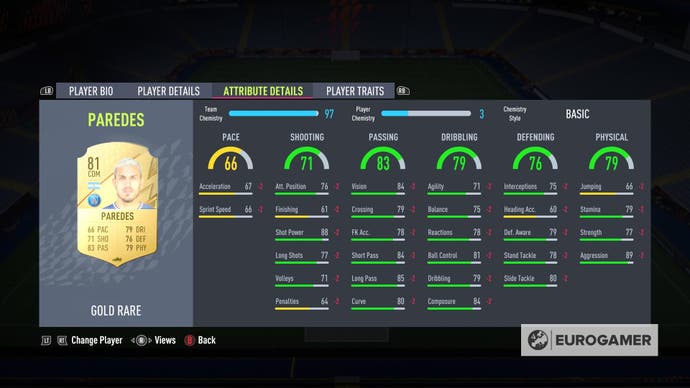
How does FIFA Chemistry work and how does it affect player stats?
With the basics out of the way, now we can get into more of the detail.
Whether or not a player's attributes change is determined by their hidden Overall Chemistry rating which, like Team Chemistry, is marked out of 100. If the Overall Chemistry rating is more than 50 out of 100, a player's attributes will increase. If it is below 50, they'll decrease, and if it's dead on 50 they'll stay the same. How much they increase or decrease by depends how far over or under 50 that player's Overall Chemistry is.
How much of an increase or decrease you get, exactly, depends on a few things.
Generally it's a case of the higher the Overall Chemistry is, the greater the increase will be, with 100 Overall meaning a maximum increase (which grants 90 attribute points, spread across attributes according to the Chemistry Style attached), and likewise the low the Overall Chemistry is below 50, the greater the decrease.
So, if you want to know exactly what a player's individual Attributes will be at any point, you first need to know what their Overall Chemistry is, then you need to know what Attributes are affected by the Chemistry Style you have attached, and then, finally, you need to know how that Overall Chemistry impacts the Attributes of that Chemistry style. Simple! Ish. Let's start with Overall Chemistry then.

How to work out a player's Overall Chemistry:
- Multiply their Individual Player Chemistry by 10, and then by 0.75
- Multiply the Team Chemistry by 0.25
- Add the two results together
So for example, if I have Cristiano Ronaldo with a Player Chemistry of 9 and his Team Chemistry is 90, that would be 67.5 + 22.5, totalling an Overall Chemistry of 90 out of 100. That's above 50, so Ronaldo's attributes would increase, and it's quite a bit over 50 too, so they would increase by quite a lot - almost the maximum amount, in fact.
Which attributes increase, and the maximum amount they can increase by, is determined by Chemistry Styles, which we explain - along with which positions they suit best - in our FIFA 22 Chemistry Styles guide.
Worth bearing in mind at this point, too, is that Chemistry ratings are calculated at the start of a match, and are thus unaffected by any substitutions, formations, or general team management changes made after the match starts.
How much does Chemistry increase or decrease player attributes by?
The exact numbers are now finally available, so here's the formula:
- Overall Chemistry - 50 = X
- X divided by 50 = Y
- Y multiplied by the "Maximum Boost Value" (the max an attribute can be boosted by a Chemistry Style) = the attribute change
Let's put that into an example to show it in action, using Ronaldo and his 90 Overall Chemistry again, with a Sniper Chemistry Style attached, and we want to find out the impact that has on his Finishing attribute. As you'll see in the big list we put together in our Chemistry Styles guide, the "Maximum Boost Value" for the Finishing Attribute granted by the Sniper Chemistry Style is 15. Or in other words, with max Chemistry, a Ronaldo card with the Sniper Chem Style would get a +15 boost to finishing.
- 90 - 50 = 40
- 40 / 50 = 0.8
- 0.8 x 15 = 12
- So, a Ronaldo card with 90 Overall Chemistry and a Sniper Chemistry Style would get +12 added to his Finishing Attribute.
Here are a couple of other things that are worth bearing in mind:
- The maximum increase, if a player has 100 Team Chemistry and 10 Individual Chemistry, is a total 90 attribute points, spread out according to the player's Chemistry Style (even if they just have the Basic one, it's still spread across specific attributes).
- The maximum decrease, if a player as 0 Team Chemistry and 0 Individual Chemistry, is a decrease of 25 points in every attribute.
Stuck for who to make up your team? We have pages on FIFA 22 Wonderkids, the best FIFA 22 goalkeepers, best FIFA 22 defenders, best FIFA 22 strikers, best FIFA 22 wingers, and the best FIFA 22 midfielders. For FUT fans, we have guides to how Chemistry works and a full Chemistry Styles list, too.
How to increase Chemistry in FIFA Ultimate Team
Individual Player Chemistry and Team Chemistry are both increased in similar ways, with a variety of factors raising or lowering their ratings. For maximum results you'll want to get 10 and 100 in both respectively, but it's worth emphasising that Invididual Chemistry is more important than Team Chemistry when it comes to calculating it Overall.
Here's how to increase Chemistry in FIFA 22:
- Player Position - A player's position, marked under their card, will show up as either red, yellow, or green. Red means they're totally out of position, reducing both Player and Team Chemistry. Yellow means they're partially out of position, decreasing Player and Team Chemistry. Green means they're in their preferred position, increasing Player and Team Chemistry.
- Player Links - Indicated by the coloured lines between players, these will show up as either red, yellow, or green again. This time, it's what the two linked players have in common (out of club, league, and nationality) that dictates the colour of the link. Red means nothing in common, decreasing Player and Team Chemistry. Yellow means one thing in common, increasing Player and Team Chemistry - note that this is different to the outcome of an yellow player position indicator. Green means two or more qualities in common, increasing Player and Team Chemistry by more than yellow. The real outcome, however, is determined by all of the links from a player: see red as -1, yellow as +1, and green as +2. Totalling up all the links, you'll want to end up positive for that player to gain a Chemistry boost from them.
- Manager - Similarly to player links, Manager nationality and league (but not club) has an impact on both Player and Team Chemistry. Each player which shares either a league or nationality link with the manager will receive a Chemistry boost, as shown by the small green Tie icon on their card.
- Loyalty - Players who have played 10 or more matches for your Club will receive a loyalty bonus, increasing their Player Chemistry by 1. This is indicated by the green shield icon on their card.
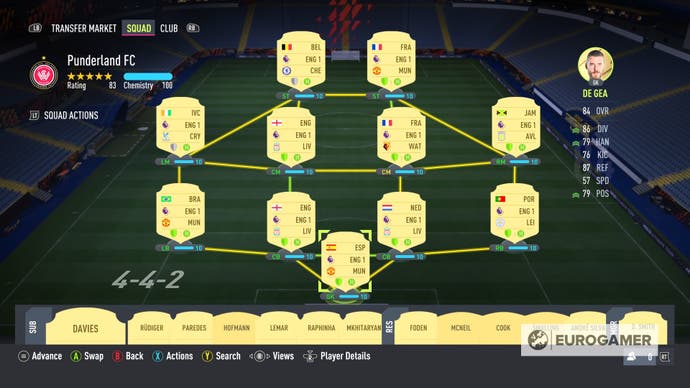
It's worth noting that although all of these factors affect both Team and Player Chemistry, it's still possible to have a high Team Chemistry and a lower Individual Player Chemistry for a certain player.
That's because the amount of Team Chemistry you'll generate from the factors above can total up to well over the 100 required to max it out - it only takes a full set of yellow links between players, for instance, to hit 100 Team Chemistry, so adding in some green links means you could stick a goalkeeper up front and still hit the 100 mark with relative ease.
Likewise, you obviously can get away with several red links on your teamsheet, so long as you have enough greens and yellows present to make it up. Players in the community, in fact, have made their own challenge out of trying to attain NLW, or 'No Links Wasted' teams for instance, where each player has exactly 9 Player Chemistry - no more, no less - that's tipped over to 10 by adding a manager or loyalty bonus.
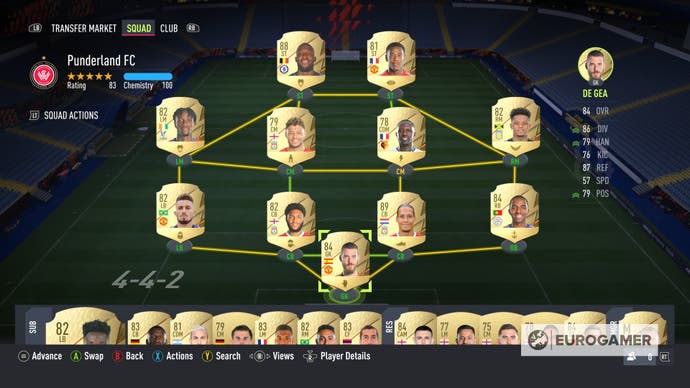
Finally, a word on substitutes in FIFA Ultimate Team. In their forum post, EA Sports clarified that subs are, in fact, unaffected by the normal Individual Player Chemistry factors listed above. Instead, all substitutes enter the game with a flat Individual Chemistry rating of 5 out of 10, meaning that, when entered into the formula above, their hidden Overall Chemistry stat will sit at a maximum 62.5 out of 100. A lower than 100 Team Chemistry will of course lower it further.
Substitutes, then, can be subbed into any position - so your LW Ronaldo can be played as a ST - without any detriment to their Chemistry rating. Instead, their performance is only affected by Team Chemistry, which as we mentioned above is calculated before the match starts, and unaffected by substitutions, formations, or other team management changes mid-game.
It also means there's a hard cap on how much their Attributes can be increased by Chemistry Styles, too. Put that 62.5 Overall Chemistry into the formula above and Ronaldo's Finishing Attribute will be increased by just 4 points (rounded up from 3.75), out of the maximum 15. Basically, subs are great for bringing on players that would otherwise have poor Chemistry, like ones from a different leage - but they're never going to be as strong as if they started with full Chemistry overall.





